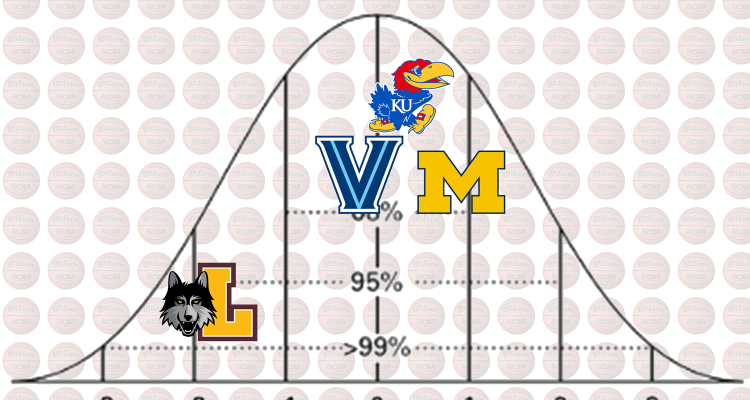By: Richard W. Sharp. Graphics: Patrick W. Zimmerman.
And here we are, after all the sound and fury of the opening rounds, left with some unlikely players, statistically significant of nothing, squaring off against the usual suspects. Despite an upset for the ages,1 the Final Four is composed of two number 1-seeds, a 3-seed, and an 11-seed. This is not exactly unprecedented. In fact, we don’t have to go back far, 2011, to find a much less likely Final Four: #3 UConn, #4 Kentucky, #8 Butler, and #11 VCU.
Words, words, words. Enough words.
To the brackets!
Scoring the Brackets
But what about the Infallible Braculator? Most of our brackets (at least a third in each family) have Villanova going all the way, and several also have Kansas. Picking the winning team is worth 1/3 of the total points in our scheme.2 Of course, if Villanova wins, there will be several other folks in the pool who also made this choice, but we’ll be in striking distance. The Braculator is doing just fine.
Check out the charts below for the latest results for points earned through the first four rounds and total points possible. Box plots above show the range of scores for each of the previously introduced scenarios. Scenarios without noise, such as the Poll of Polls (aka chalk), contain only a single bracket and therefore only a single score.
Mouseover for details.
Mouseover for details.
The Braculator is still doing well as compared to the Poll of Polls, mainly on the strength of Villanova.
The Upsets
The first two rounds had some real doozies. UMBC wiped 63 points off of a lot of brackets (including the Poll of Polls) when they took down Tournament Goliath, Virginia. North Carolina’s drubbing took a bite out of many of our model’s brackets. And Obama’s Final Four picks: Virginia, UNC, Michigan St., and Villanova make him look like a lightning rod for upsets (is there an award for worst sensible bracket?).
The third and fourth rounds didn’t disappoint, either. Every win for Loyola is an upset by definition, but the upsets have stopped mattering in terms of winning brackets. Most of the matchups that produced these latter round upsets were so unlikely in the first place that they don’t appear on almost anyone’s sheet.
At this point our fortunes are tied to the top seeds, and mainly to Villanova. Their fate is all that matters.
The table below lists all of the upsets so far along with the difference in pre-tournament team ranks (Massey rank), the margin of defeat, the difference between seeds, and the number of points each upset cost the Poll of Polls.
Mouseover for details.
To show how the upsets impacted each family of modeled brackets, the histograms below show how many brackets lost a significant number of points for a particular upset (select the losing team for each upset with the filter at the bottom of the chart).
Mouseover for details.
Conclusion
Yay! Just when you thought you were out, statistical inevitability pulls you back in. Go Villanova, who will be king hereafter (we hope).
Notes:
1 Trivia buffs will do well to remember that it took 135 meetings of 1 and 16 seeds to produce the first upset.^
2 Recall, we’ve scored each bracket according to a standard scheme in which a correct pick receives 1 point in round 1, 2 points in round 2, 4 points in round 3, and so on, up to 32 points for the championship.^


No Comments on "Bracketeering Final Four update: Round of the Usual Suspects (and Loyola)"